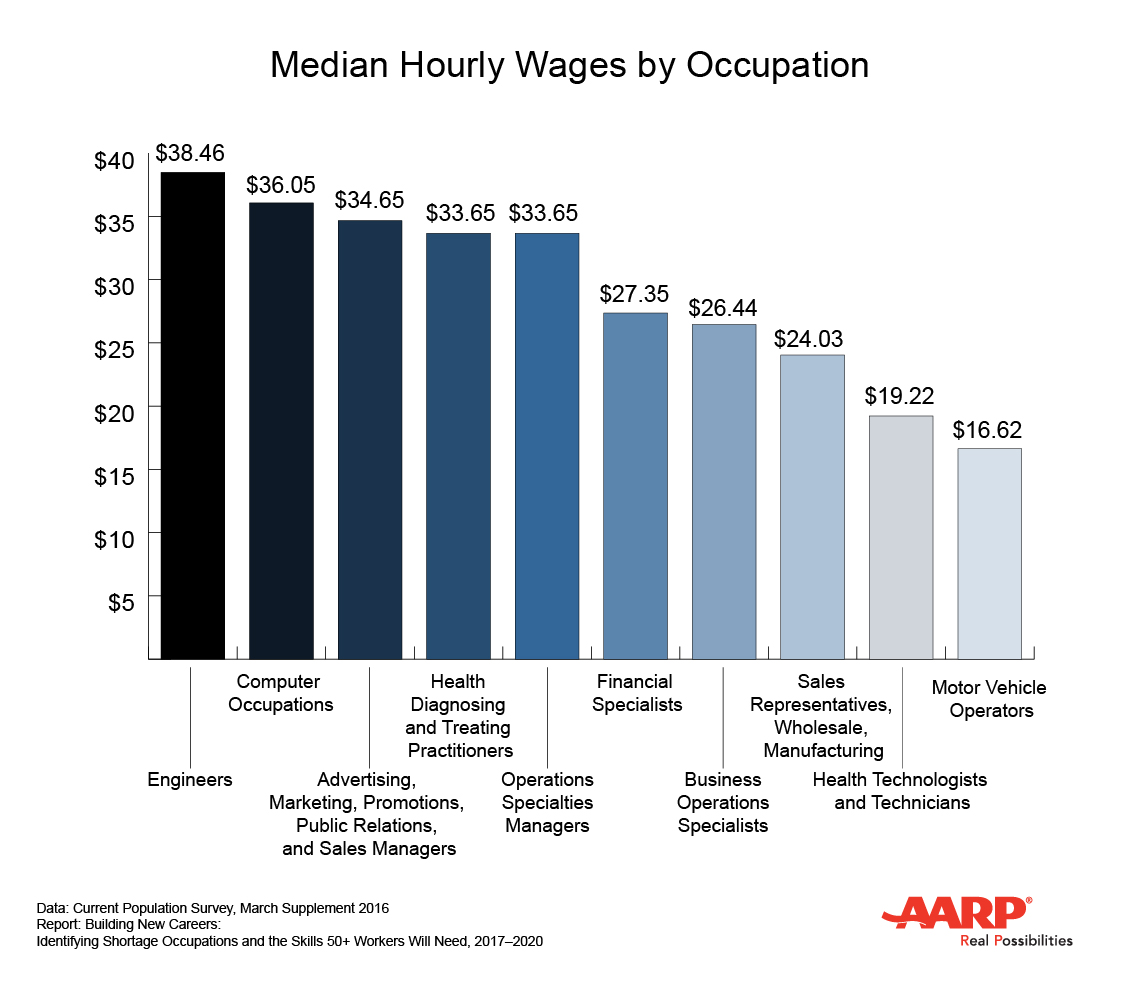Building New Careers
Identifying Shortage Occupations and the Skills 50+ Workers Will Need, 2017-2020
A new report from AARP identifies in-demand jobs that 50+ workers could fill, if prepared with the right skills and given the opportunity.
While older workers generally have low levels of joblessness—about 3 to 4 percent—they face challenges in the labor market. Those 50+ who are out of work are more likely to be unemployed longer. They also encounter barriers to career re-entry and advancement, along with stagnant wages. Yet, compared to younger workers, employers say older workers are more reliable and accurate in their work, and often have better social skills.
To better match capable 50+ workers with the needs of businesses, AARP recently partnered with IMPAQ International, LLC to analyze future openings in the job market. “Building New Careers: Identifying Shortage Occupations and the Skills 50+ Workers Will Need, 2017-2020” provides recommendations for policy makers and others interested in helping 50+ workers to move into promising occupations where employers are struggling to find talent.
Hot Jobs
Using forecasting techniques and data on job postings and unemployment, researchers identified the occupations likely to have the largest labor shortages between 2017 and 2020. In order of highest projected demand:
- Health Diagnosing and Treating Practitioners (chiropractors, dentists, surgeons)
- Sales Representatives, Wholesale and Manufacturing (sales agents, sales executives, direct salespersons)
- Computer Occupations (computer systems analysts, computer programmers, and web developers)
- Advertising, Marketing, Promotions, Public Relations, and Sales (marketing managers, sales managers, fundraising managers)
- Motor Vehicle Operators (taxi, bus, and ambulance drivers)
- Health Technologists and Technicians (dental hygienists, radiologic technicians, paramedics)
- Engineers (biomedical engineers, civil engineers, mechanical engineers)
- Business Operations Specialists (claims adjusters, labor relations specialists, logisticians)
- Financial Specialists (accountants, personal financial advisors, loan officers)
- Operations Specialties Managers (human resource managers, industrial production managers, computer and information systems managers)
The good news is that older workers are already well-positioned to fill many of these openings. The analysis shows that nearly 25 percent of the 50+ workforce is employed in one of the top 10 shortage occupations. Another 20 percent are working in fields that require related knowledge and skills.
But to move into these growing occupations, additional training may be needed. Analysts identified instructional programs and credentials that workers would need to compete for openings in the shortage occupations. The report examines how to best strategically place resources, based on the time and expertise needed to transition into the various occupations.
Which Jobs Are Right for Which Individual?
To be sure, different occupations call for different approaches. Health Diagnosing and Treating Practitioners, which accounts for the largest share of anticipated job openings (13.8 percent), includes positions—such as pharmacist, therapist and orthodontist—that require years of training. Analysts, therefore, suggest a focus on advancement of professionals within those fields— rather than preparing new entrants. It may be better to invest, instead, on training workers in Sales, Motor Vehicle Operation, and Health Technology, where duration of training is shorter, according to the report. Computer Occupations, meanwhile, are projected to have a shortage and make up 9.4 percent of all job postings in the next three years, but only 2.2 percent of the 50+ workforce currently works in these or similar occupations. Therefore, preparing older workers for this field may be impractical, the report suggests.
Just how much money could workers expect to make in the top 10 growing occupations? Engineers fared the best with a median hourly wage of $38.46, followed by computer occupations ($36.05) and jobs in advertising, marketing and promotions ($34.56). Motor Vehicle Operators had the lowest median wage at $16.62 per hour, although those jobs may provide greater opportunity to workers over 50 who are not already in any of the top-shortage or related occupations. Overall, the report shows wages increase along with training requirements.
Because labor markets and characteristics of the workforce vary by region, the report analyzed findings both at the national and state levels.
Across all regions, Health Diagnosing and Treating Practitioners are expected to have the largest shortages and, in many instances, the largest share of jobs. Other job and industry shortage areas that comprise at least 4 percent of the 50+ workforce - for the nation as a whole - are Sales Representative, Wholesale and Manufacturing; Health Technologists and Technicians; and Motor Vehicle Operators. The report revealed some regional variation: for instance, Top Executives make the top 10 shortage occupations list in the Northeast, but not Motor Vehicle Operators.
The report concludes that preparing older workers to be competitive in shortage occupations can help address some of the challenges they face and build on the soft skills that are an existing strength among this segment of the workforce. With specific information about in-demand jobs and training requirements, resources can be targeted—particularly in major metropolitan areas—to better match 50+ workers with promising career prospects.
Following is a state listing of projected occupational shortages infographics for 2017-2020:
For more information, contact Rebecca Perron at RPerron@aarp.org.
Suggested Citation:
Perron, Rebecca. Building New Careers: Identifying Shortage Occupations and the Skills 50+ Workers Will Need, 2017-2020. Washington, DC: AARP Research, October 2017. https://doi.org/10.26419/res.00056.001
Search AARP Research
Enter a keyword below to find answers to your AARP Research questions.
Caregiver Costs
Caregiving Comes with Financial Burdens
In 2016, family caregivers spent on average just under $7,000 per year, or an average 20% of their income, on caregiving expenses.
Find Out More



